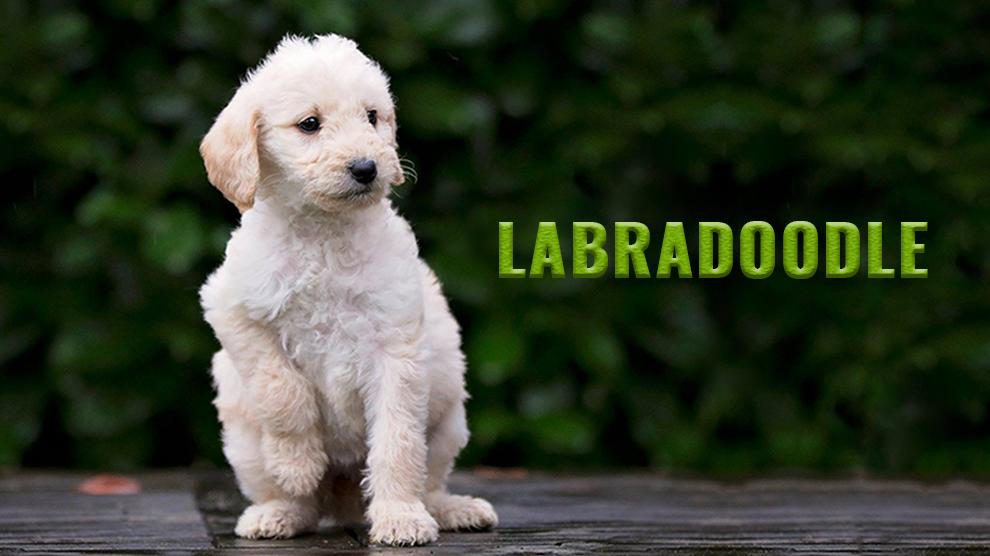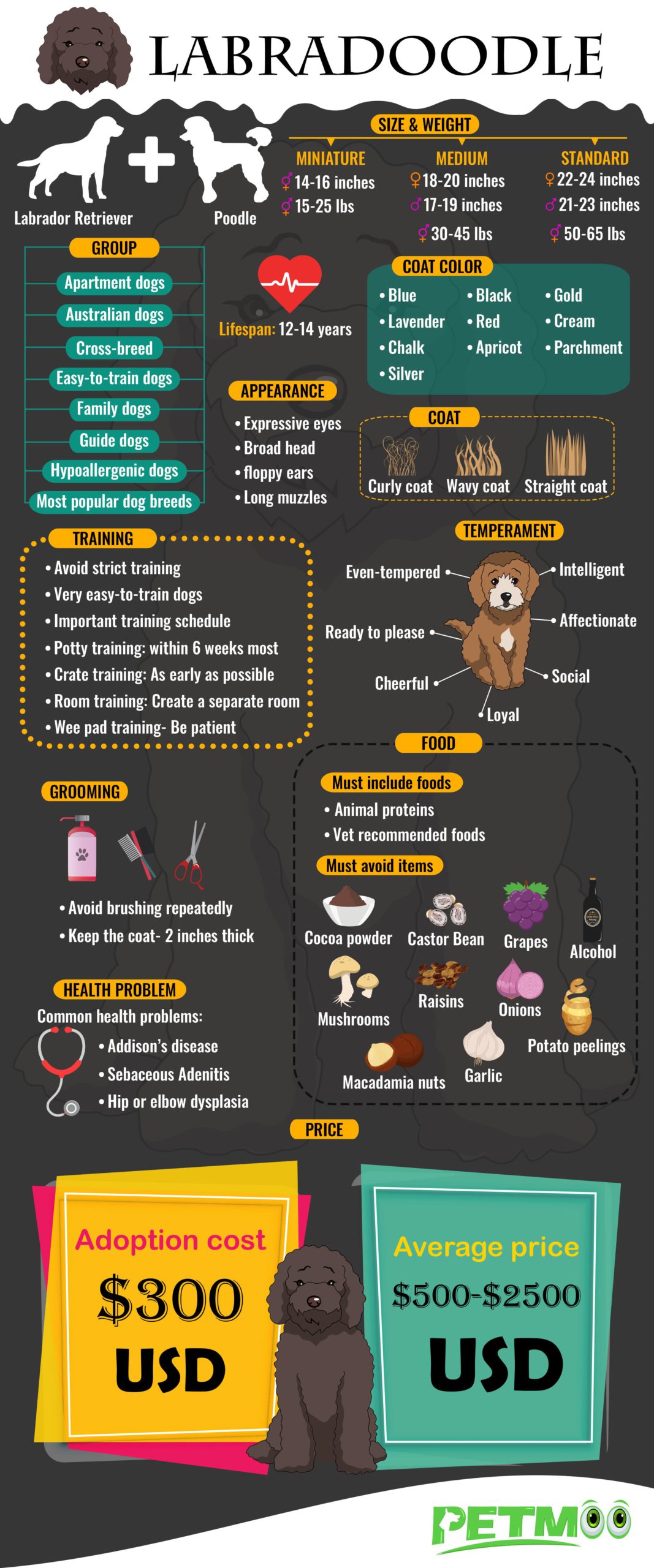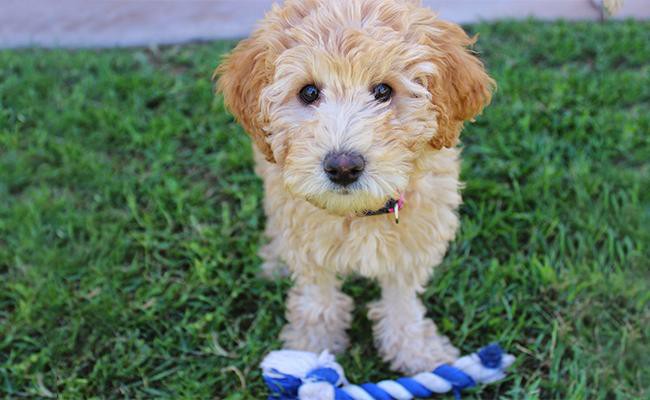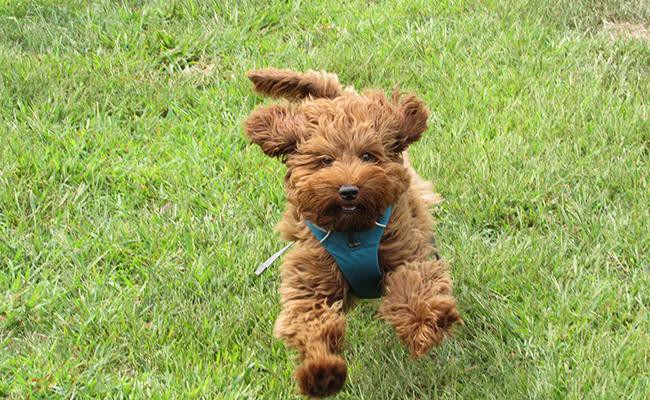Dog Pregnancy Calculator And Timeline
Labradoodles won many hearts in a shorter span of time. Initially created to be a hypoallergenic dog, the Royal Guide Dogs Association of Australia produced the first crossbreed of Labrador Retriever and a Poodle in the year 1989.
The cross yielded a lovely, smart dog which is also a good therapy dog. They have a curly or shaggy coat that requires meticulous maintenance.
Labradoodle Breed Characteristics Sheet
- Origin: Australia
- Size: Medium
- Dog Breed Group: Guide/family
- Purebred: No
- Lifespan: 12-14 years
- Height: 22-24 inches(male), 21-23 inches(female) -Standard, 18-20 inches(male), 17-19 inches(female)-Medium, 14-16 inches- Miniature
- Weight: Weight: 15-25 lbs(Mini), 30-45 lbs(Medium), 50-65 lbs (Standard)
- Coat Appearance: Curly, wavy, or straight
- Coat Colors: Apricot, red, black, silver, chalk, gold, cream, chocolate
- Temperament: Affectionate, Cheerful, Energetic, Friendly, Semi-independent, Intelligent, Obedient
- Good With Children: Yes
- Intelligence Level: High
- Good With Pets: Yes
- Hypoallergenic: Yes
- Grooming: Low
- Shedding: Shed Moderately
- Barking: Low
- Suitable For Apartments: Yes
- Need For Exercise: High
- Easy To Train: Yes
- Good For First Time Owners: Moderate-High
- Health Issues: Hip and elbow dysplasia, Sebaceous Adenitis, Addison’s disease
- Litter Size: 8 puppies (average)
- Average Price: $500 – $3000 USD (USA)
Labradoodle History
This dog is an attractive cross between a Standard or Miniature or Moyen Poodle and a Labrador Retriever.
This hybrid dog is highly friendly, smart, and reasonably healthy like its parent breeds.
The term “Labradoodle” first gained focus in 1955 but reached more popularity, not until the year 1988.
Bear in mind, not all dogs of this breed remain hypoallergenic. It is this quality many dog lovers look for and loved in this crossbreed.
In 1988, it became quite popular when Wally Conron mixed the Standard Poodle and Labrador Retriever at the Royal Guide Dogs Association in Victoria, Australia.
Conron believed that the Poodle’s non-shedding trait and smartness would combine with the sturdy Labrador’s obedience and trainability.
They are still seen as guide dogs, working dogs, and as service dogs.
Is Labradoodle The Right Choice For You?
If you prefer a dog who……
- Tends to behave obediently after training
- Is smart and active
- Comes with a variety of fur
- Is a solid companion
- Performs well both as a guide dog and as a pet
What are you waiting for? You are ready to bring home a Labradoodle puppy.
If you are looking for something sober and lazy, then you better skip this dog breed.
Labradoodle Size And Lifespan
Size
They are widely available in different sizes. The first-generation breeders determine the actual size of this puppy.
Labradoodles come in three sizes as standard, medium, and miniature.
Miniature Labradoodle
Size – 14-16 inches
Weight – 15-25 lbs
Medium Labradoodle
Size – 18-20 inches(male), 17-19 inches(female)
Weight – 30-45 lbs
Standard Labradoodle
Size – 22-24 inches(male), 21-23 inches(female)
Weight – 50-65 lbs
Labradoodle Lifespan
The average lifespan of this dog is between 12-14 years. Some are known to live much longer if given more dedication and care.
Labradoodle Facts
Labradoodle Colors
- Blue
- Lavender
- Chalk
- Silver
- Black
- Red
- Apricot
- Gold
- Cream
- Parchment
- Café
- Chocolate
Their coats are mainly divided into three different categories: hair, fleece, or wool. Australian Labradoodles comprise of fleece coats that appear wavy or straight only.
Hair and wool coats are predominantly seen in early generation dogs.
Labradoodle Appearance
Coat:
They are an excellent choice for normal allergy sufferers. There are basically three distinct coat types:
- Curly coat – Thick, dense curls that are non-shedding and have no odor
- Wavy coat – “Fleece coats;” low shedding and silky waves
- Straight coat – “Hair coats;” this variety sheds the most
Face
They have floppy ears, a broad head, and large, expressive eyes. This mixed breed is known for its scruffy look.
These dogs have long and soulful muzzles, sometimes mischievous looking eyes are covered in soft distinct curls.
With rounded cut around and near the pads, They look best with trim nails and pads.
Labradoodle Temperament
Labradoodles are well known for their cheerful disposition, sociability, affection, level-headedness, and intelligence.
Initially a cross of a Standard Poodle and a Labrador retriever, nowadays, they have become multi-generation dogs.
These dogs are easily outgoing and not pushy and aggressive. They are kind, gentle, even-tempered, ready to please, friendly, and loyal.
This mix of traits makes them brilliant therapy and service dogs, and excellent family dogs.
They are not considered as good guard or watchdogs. Dog owners should be cautious enough not to allow this dog to become over friendly.
Labradoodle Interesting Facts
- Sultan, the first produced Labrador-poodle mix was hypoallergenic.
- In Hawaii, Sultan worked as a guide dog.
- Labradoodles love people and they actually live to love.
- A smart dog of this breed did something unimaginable. He traveled two counties, almost 12 miles and fooled a 6-foot fence on its way to meet his owner.
- Norwegian Princess, Golf champion Tiger Woods, and Hollywood actress Jennifer Aniston all own cute Labrador-poodle mix dogs.
- They are almost non-standardized and unpredictable.
Labradoodle Care
Your new Labradoodle puppy would have met your local veterinarian by the time he is around 8 weeks old. Your vet would have suggested at least the first puppy vaccination shot and deworming medicine as well.
The vet will recommend follow-up shots once every three weeks. You can start flea or tick and heart guard medications at around 10 weeks. After that, the puppy should attend regular vet check-ups.
Labradoodles are very healthy dog breeds and puppies purchases from reputable breeders have little or no health issues.
According to trainers, the most vital period for any puppy is between 8 & 11 weeks.
Simple Tips To Handle A Labradoodle Puppy
1. Puppy proofing your home is the first thing you should do before the puppy arrives. Try and remove all the small objects, toxic plants that could cause choking problems to your puppy.
Close all the open electric chords because it can cause unnecessary electric shocks. If there is an open yard, you better fence that part. Fencing will save your dog from running astray and getting injured.
2. The second most important thing is to remove all dangerous trees, flowers, bushes, and trees from your yard. Plant pet-friendly plants.
Using organic manures in your garden is the right way forward. Toxic garden chemicals can enter your puppies body through their paws.
3. Prepare a special place with a cozy bed and toys
You should divide a private area for your dog to take rest. Install a doggie gate and ensure that your dog is safe and secure.
Kindly avoid shutting a door. This will increase the insecurity of your dog. Providing a cozy bed to your dog is important for his growth.
Place the bed in a calm area and you can also try the latest orthopedic beds available in the market.
Interactive toys as well as other types of play items including balls, rope toys, squeaky toys, and plastic dog toys, and stuffed animals are also a better option to keep your dog mentally and physically active.
Labradoodle Grooming
It can keep its long coat and have a scissor cut at least once or twice. You should leave the coat at least six inches thick. Cut it back to two inches.
Start the grooming all over if needed.
- Brush the coat completely
- Use thinning shears and thin mats
- Trim as short as possible around tush, eyes, and lips
- Wash using shampoo and spray using a detangler
- Avoid brushing repeatedly
- Format care, thin area using thinning shears. Brush only that area, apply some water. Allow it to
- Trim the edge (feet) so that ice does not form in the winter months
- They are good swimmers. Keep the coat to a 2-inch thickness
- Use tweezers and pull out excess hair from their ears.
- For toenails, you can call a groomer or do it using a trimmer
Labradoodle Shedding
These breeds are considered as low shedding dogs. They shed between very low and average shedding. They tend to shed less and they are considered hypoallergenic.
How To Train Labradoodle Puppies?
The best puppies are fully aware of their boundaries. The sooner you train your Labradoodle puppy the sooner it gets freedom.
Strict training results always provide big points for owner and puppy.
Labradoodle puppies are intelligent and simple to train. These dogs should be potty trained within 6 weeks most. Most dogs are retrieving, shaking, staying, and sitting paws by three months.
Crate Training
The puppies view crave as a very safe place and the ideal crate should remain big enough so that they can lay down, walk, or stand up.
The first time places the crate in the in your bedroom and then later move the crate to a safe place.
Some puppies pee instantly in their crate. You better have patience.
The main aim of using the crate is actually to stop peeing at least for some period of time. Never leave water and food in the crate for a long time.
Always never leave the dog with the collar on.
Room Training
Create a safe room so that your dog can stay there until the not so friendly “dog people” visit. The room should be equipped with toys and a wee pad.
Wee Pads
Place the wee pads as close as possible to the bed or at some other safe place. Please do not punish them for using the wee pad.
Labradoodle Food
Protein sources
The main food source should include animal protein. Grain or vegetable protein is not a good option.
Avoid food that lists more grains in their top 5 ingredients. If that’s the case, you can select chicken.
Grain sources
Grains such as wheat gluten, corn gluten, corn, and soy can be quite hard to digest. This means possible allergic reactions and less nutrition.
Oatmeal, corn, rice, barley, and wheat are not the main food sources a dog instantly take a liking.
These ingredients can cause stomach issues if left unnoticed.
Fat Sources
Animal sources like chicken, meat, fish, and eggs in proper form are easily digested and give more strength and energy to your dog in general.
Toxic foods
Some of the toxic items to your Labradoodle puppy :
- Mistletoe
- Aloe Vera
- Umbrella Plant
- Caladium
- Asparagus Fern
- Virginia Creeper
- Cherry
- Japanese Plum
- Wild Cherry
- Yew (all varieties)
- Apple (leaves and stem)
- Raw salmon
- Broccoli
- Tomato stems and leaves
- Hops
- Caffeine
- Yeast dough
- Alcohol
- Spoiled foods
- Potato peelings
- Onions and garlic
- Macadamia nuts
- milk chocolate (all types of chocolate)
- Cocoa powder
- Castor Bean
- Mushrooms
- Xylitol items-candy, gum
- Raisins and Grapes
Labradoodle Puppy Names
| Male | Female |
|---|---|
| Alvin | Kylee |
| Cam | Molly |
| Goro | Janie |
| Danny | Maddie |
| Eliot | Bailey |
| Izzy | Lexi |
| Floyd | Willa |
| Gulliver | Sasha |
| Gabe | Nadia |
| Ike | Nina |
Labradoodle Health Problems
Some of the common health problems that affect Labradoodles include:
Addison’s disease
Also called hypoadrenocorticism happens due to malfunction of the adrenal glands. These glands are responsible for water, sugar, and salt balance in the body. This disease also affects the production of cortisol in dogs.
A dog will find it hard to digest food or manage stress without enough cortisol.
Other side-effects of Addison’s disease include excessive urination, thirst, diarrhea, loss of appetite, depression, and fast heart rate.
Eye Problems
They are prone to certain eye problems including cataract and progressive retinal atrophy(PRA). These problems must be treated early; else, may end up in blindness.
Sebaceous Adenitis
Sebaceous Adenitis is a rare skin problem that affects all aged dogs. This condition causes odor, scaling, bacterial infections, skin lesions, and hair loss. Vets suggest antibacterials, shampoos, and oils for relieving pain.
Hip or elbow dysplasia
The hip or elbow joints grow awkwardly. The abnormal shape stops the sockets and joints from meeting one another. This leads to grinding and rubbing.
Hip dysplasia means joint instability while elbow dysplasia causes bone pieces to get lodged in the joint. With time, this condition can lead to secondary osteoarthritis and lameness.
A surgery can prevent arthritis if done early and get a vet to check your puppy before bringing him home.
Labradoodle Price And Breeders
Labradoodle Adoption
You can get a puppy from a shelter at a lower price when compared to a breeder. The adoption cost works out to around $300 USD. The average cost of the puppy is between $500-$3000 USD. Make sure you get your puppy from reputed breeders with proper papers and not from puppy mills.
Labradoodle Breeders
For more details contact:
Australian Labradoodle Club of America
829, Whisper Way
Bellingham, WA 98226























